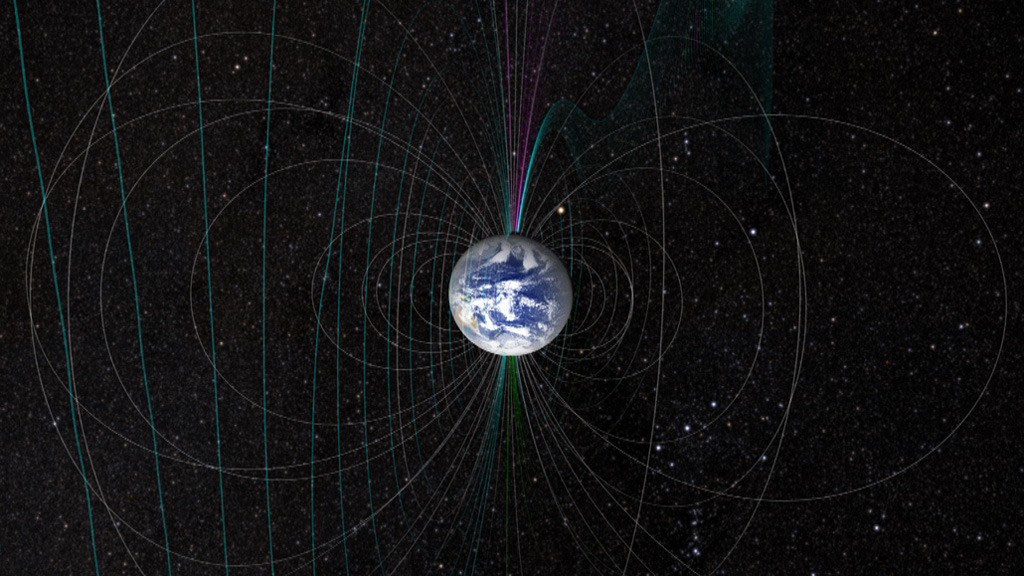Earth's Magnetic Pole Is Wandering, Lurching Toward Siberia

Earth's north magnetic pole is on the move, unpredictably lurching away from the Canadian Arctic and toward Siberia. It's wandered so much, that the current representation of the entire globe's magnetic field, just updated in 2015, is now out of date. And so, geologists have come up with a new model.
This updated model, called the World Magnetic Model, was supposed to be published Jan. 15, but it's now been delayed to Jan. 30, on account of the government shutdown.
Once it's made public, the new model will inform a wide array of navigation, including those directing airplanes and ships to people checking Google Maps on their smart devices. [Earth from Above: 101 Stunning Images from Orbit]
The World Magnetic Model is one of a handful of models — another is called the International Geomagnetic Reference Field — that track so-called declination, or the difference between true, or geographic, north (that is, the North Pole) and magnetic north (the point where your compass needle points). Knowing that declination for points across the globe allows one to convert between a magnetic bearing and a true bearing, according to a report on the 2015 model. In that way, ships, aircraft, antennas, drilling equipment and other devices can be oriented.
The latest World Magnetic Model was designed to last until 2020, but magnetic north's rapid and unexpected surge toward Siberia was so great, that researchers had to amend the model early, Arnaud Chulliat, a geomagnetist at the University of Colorado Boulder and the National Oceanic and Atmospheric Administration's (NOAA's) National Centers for Environmental Information, told Nature.
News of the magnetic north's meanderings isn't exactly new. Researchers figured out in the 1800s that magnetic north tended to drift. Then, in the mid-1990s, it began moving faster, from just over 9 miles (15 kilometers) a year to about 34 miles (55 km) annually, Nature reported. In 2018, magnetic north skipped over the International Date Line and entered the Eastern Hemisphere.
Core message
The North Pole’s erratic movements are largely the result of Earth's liquid-iron outer core, known as the core field. (Other factors play a role, too, including magnetic minerals in the crust and upper mantle, as well as electric currents created by the flow of seawater, but these influences are small compared to those from the core field, according to the 2015 report on the World Magnetic Model.)
Get the Space.com Newsletter
Breaking space news, the latest updates on rocket launches, skywatching events and more!
No one has ever seen the core field, but you can imagine it like this: Picture a bar magnet at the center of the Earth that has two poles: north and south. This magnet represents about 75 percent of the intensity of the Earth's magnetic field at the surface today, said Ronald Merrill, an emeritus professor of Earth and space sciences at the University of Washington, who wasn't involved with the new World Magnetic Model research. (In reality, electric currents and not a giant bar magnet in Earth's core create the magnetic field, but it's easier to think of it in terms of magnets, Merrill said.)
But the intensity of this so-called bar magnet is decreasing over time, by about 7 percent every 100 years, Merrill told Live Science. That bar magnet is also moving right now, so that it's tilted toward Canada at slightly less than 10 degrees, he noted.
The other 25 percent of the magnetic field comes from another field, which can be envisioned as bar magnets that are moving around, Merrill said. In other words, as the giant, central bar magnet loses its intensity, this other magnetic field gains more influence over Earth's magnetic field. "And that's what's causing this field to move in the direction [of Siberia]," Merrill said. [Doomsday: 9 Real Ways Earth Could End]
In fact, the weakening of this giant bar magnet has alarmed some scientists, who wonder if it's a sign that Earth's north and south poles might flip, as they last did about 780,000 years ago. Such a flip wouldn't happen for thousands of years, and it remains to be seen what will happen. But a 2018 study in the journal Proceedings of the National Academy of Sciences found evidence that Earth's magnetic field has weakened before without flipping.
However, this weakening could lead to a field wobble, which could affect technologies such as electronics aboard low-Earth-orbit satellites, Live Science previously reported.
A roving magnetic north has other implications, too. As it moves, it's likely that the best locations to see the Northern Lights will change over time. "In a hundred years, there might be a better place to see the Northern Lights than there are today," Merrill said.
Digging in
For now, scientists are trying to figure out exactly why magnetic north is shooting toward Siberia. One idea is that its rapid flight is connected to a high-speed jet of liquid iron under Canada, Nature reported.
It appears that this jet is weakening the magnetic field beneath Canada by smearing it out, which means that Canada doesn't stand a chance against Siberia, Phil Livermore, a geomagnetist at the University of Leeds, in England, told Nature.
"The location of the north magnetic pole appears to be governed by two large-scale patches of magnetic field, one beneath Canada and one beneath Siberia," Livermore told Nature. "The Siberian patch is winning the competition."
Originally published on Live Science.
Join our Space Forums to keep talking space on the latest missions, night sky and more! And if you have a news tip, correction or comment, let us know at: community@space.com.

Laura is an editor at Live Science. She edits Life's Little Mysteries and reports on general science, including archaeology and animals. Her work has appeared in The New York Times, Scholastic, Popular Science and Spectrum, a site on autism research. She has won multiple awards from the Society of Professional Journalists and the Washington Newspaper Publishers Association for her reporting at a weekly newspaper near Seattle. Laura holds a bachelor's degree in English literature and psychology from Washington University in St. Louis and an advanced certificate in science writing from NYU.










